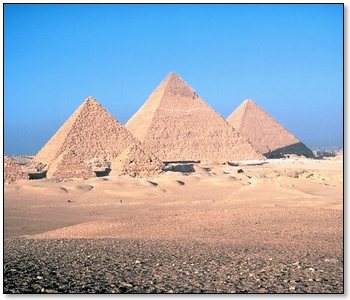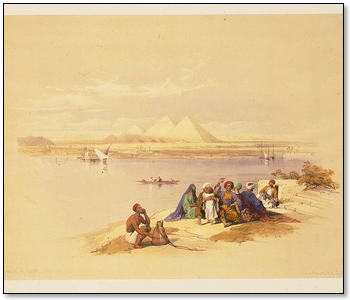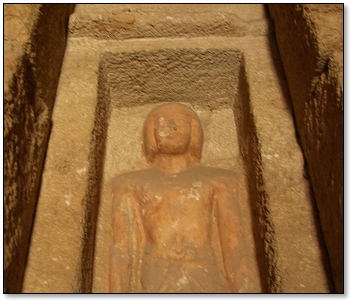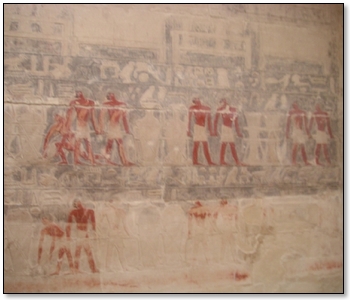Pyramids
This article discusses the history and construction of the Egyptian Pyramids.

The Pyramids
The Pyramids of Egypt have always been regarded as one of the world's wonders, even in ancient times. They are emblematic of ancient Egyptian civilization.
The pyramids are believed to be tombs of former Egyptian rulers (Pharaohs) or monuments commemorating them. The pyramids were each built at different times during Egypt's very long history, and while they share certain similarities, are each different from one another and reflect the different architectural knowledge of when they are built, as well as the varying resources of the Pharaoh that commissioned them.
The Egyptian pyramids are square-based and, except for those in the Third Dynasty, which are terraced, have four faces, with smooth edges that connect the base to the summit, on which was located a pyramidion. According to the theory most commonly accepted among scholars and confirmed by archaeological evidence, the pyramids were built as a funerary monument above the tomb of the ruler. The development of these monuments began in the Twenty-seventh century BC, the Third Dynasty, evolving from the Mastaba-style, and ended with two pyramids built during the XIII dynasty in the eighteenth century BC.
Mastabas
A Mastaba: the Predecessor to the Pyramids
The mastaba, a predecessor to the pyramids, was a type of tomb used during the early stages of Egyptian civilization. In name id a derived from an Arabic word which means "bench".
The simplest mastaba tombs consist of a "ridge" in the form a truncated pyramid. The structure contained some ritual chapels, a false door (through which the deceased was allowed to leave the afterlife to go to receive offerings deposited by the living on the appropriate table) and a shaft (closed with stones and debris, often very deep - even more than twenty meters - which gave access to the actual tomb).
The external portion of the mastaba, the one on the surface (in contrast to the well), serves to close off access to the grave beneath and symbolically represents a seal.
Mstabas were used by rulers of dynasties, as well as important members of the Court such as viziers, scribes, nobles and priests.
It is believed that the pyramids were developed from this type of structure. For example, the famous Step Pyramid of Djoser may be seen as a series of superimposed mastabas.The Pyramids
These massive buildings inspire awe and wonder. The pyramids are enormous by any standard, even when compared to today's skyscrapers. The pyramids are even more awe-inspiring when one considers how ancient they are. The youngest of the pyramids is almost 4,000 years old, the oldest is at least 4,700 years old. The Egyptians were building pyramids when most of the rest of the world had not yet developed masonry, or even settled into cities. To have had the technical know how and the social organization to muster their resources, not just of labor, but of supply including food for the workers, and stone from the quarries which were many miles distant, is a truly remarkable achievement.
In ancient Egyptian, pyramids were called wed. The word pyramid appears to have been derived from the Egyptian pre-em-us which signified only one side of the pyramid. The association with the Greek term pyramous, which signified a cake, appears to be merely coincidental and most experts believe that there is no connection between the two words.
The stepped pyramid of the Third Dynasty

A Drawing of the Pyramids
The Pyramid of Djoser at Saqqara
The first pyramid was a step pyramid, constructed in a series of smaller terraces one on top of the other, built at Saqqara for Djoser, the second Pharaoh of the 3rd Dynasty. This is probably the first monument built entirely of stone. The design was so revolutionary, that its designer, Imhotep, has been remembered throughout the ages and was even deified in Egypt as a god of architects.
This pyramid consists of six tiers, one above the other. It has a rectangular base of 109m by 121m and a height of 59.93 m (now reduced to 58.63 by erosion). The interior contains a network of tunnels and shafts, the center of which is the burial chamber of Djoser. Some tunnels were meant to house the coffins of members of the royal family. Other galleries served as warehouses and contained about 40,000 jars of alabaster, porphyry and other precious stones.
The stone blocks used are slightly larger than bricks previously used in the construction of raw mastaba. Many of the structures built with these blocks mimic the form elements consisting of perishable materials such as logs, mats and bundles of reeds. Analysis of the structure allowed to demonstrate that it is the result of four successive changes in a project which originally involved simply a great mastaba.
The pyramid is the most important building of a funerary complex that included temples and other buildings and occupied an area of over 15 hectares enclosed by a wall about 10 meters high. There was only one true gateway to the complex, but along the wall there were also 14 false doors.
Other Stepped Pyramids
In addition to the pyramid of Djoser, there are two other great funerary complexes with stepped pyramids from the Third Dynasty, that of Sekhemkhet, also at Saqqara and one found at Zawyet el-Aryan, which was attributed to Khaba. The pyramid complex of the latter, known as a Layer Pyramid, is a pyramid formed by independent layers resting one on top of the other. The original height must have been around 41 meters, but the remains currently measure only 16 meters, due to erosion and the passage of time.
Four other small step pyramids from the end of the dynasty are known to exist.
The Pyramid of Meidum
The last ruler of the Third Dynasty, Huni, built around Meidum the last and largest of the step pyramids. Analysis of the remains showed that the pyramid consisted of seven or eight steps, with a side of base of about 122 meters and a height of 82 meters.
During the reign of Snefru, the founder of the Fourth Dynasty, it was decided to turn the pyramid of Huni in a regular pyramid, the first of its kind, bridging the gaps between the steps and adding a coating. The geometric pyramid that resulted had a base side of 144m and height of 91.7 m.
Over time, the deterioration of the monument caused the terraced structure below to resurface, as the overlay was eroded. In the fifteenth century we know from Arab authors there were still visible five steps. Today all that is left of the pyramid is a large mound with a square base, surrounded by a hill of debris.
The pyramids of the Fourth Dynasty

The First Pyramid Ever Built
Pyramids of Snofru
Typically, Egyptian rulers built one pyramid to house their remains and to be their palace in the afterlife. Snofru, for reasons that are unknown to us, built three pyramids: the one at Meidum (discussed above), and the Bent Pyramid also known as dual gradient pyramid, and the Red Pyramid, both at Dahshur.The pyramids of Snofru, and their surrounding funerary complexes, differ significantly from those of the Third Dynasty. They do not make use of false doors on the wall of the points that imitated logs or other perishable materials. Furthermore, the structure of the complex becomes open: the surrounding wall no longer surround numerous buildings, but only the pyramid itself., the funerary temple, built at the eastern side of the pyramid, and a small satellite pyramid, which appears for the first time next to the Dual Slope Pyramid. The Ceremonial Way, which starts from the funerary temple, exits the wall area and reaches another temple by the banks of the Nile.
In the case of the Double Sloped Pyramid, the ceremonial way is 704 m long, while the fenced area is a square of about 300 meters on each side. The name of the pyramid comes from its most striking feature: it is not a true pyramid because the faces, joined at the height of 49 meters, have sharply varying slopes ranging from 54 ° 3 'to 43 ° 21'. The base is 188.6 m on its side and the original height was 105m.
The Red Pyramid of Snofru
According to the most plausible interpretation, the strange shape of the pyramid is the result of a design change made during construction. Due to collapses in the internal structure (the cracks are still detectable) which occurred when the pyramid had reached about half of its expected height, it was decided to decrease the slope of the upper part in order to not increase the load excessively. The failures were due to an incorrect construction of the roof of the burial chamber that was made flat instead of a pyramid. The change of slope was not achieved by chance but was made to alter the pyramid shape to that of an obelisk. despite the failure of the original design it was simply not possible to admit defeat in the construction of a building so important, it had to be completed even if that meant changing its original design. Perhaps this is a clue to why Snofru built more than one pyramid; he may simply have been dissatisfied with the result.
Not far from the previous one, also in Dahshur, Snofru he built the Red Pyramid, also called the North Pyramid North. This is the first pyramid designed and built as regular geometric pyramid. It was originally coated with Tura limestone, which was removed almost completely in the Middle Ages and used in other buildings.
The base is not a perfect square, but a rectangle 218.5m by 221m, 5, the height is 104.4m and the slope 43 ° 36 ': one of the lowest among those of Egyptian pyramids.
The Pyramids of Giza

Egyptian Statue
The Great Pyramid
The successors of Snofru, building on experience gained in the two previous centuries, constructed the pyramids of Giza plateau, which are the largest and most famous in history.
The Proportions became gigantic. The largest pyramid, was the first erected at Giza and was commissioned by the Pharoah Cheops. The sides of the base, which is almost exactly a square, measure 230.4 meters, 230.51, 230.6, 230.54. The original height was 146.7 m. The sides are oriented to the cardinal points (west,east,south,north) with an amazing precision: the error is only about 3 degrees, despite the fact that the Egyptians lacked any sophisticated surveying equipment..
The Great Pyramid of Khufu (Cheops)
The Great Pyramid of Khufu (Cheops) is undoubtedly the most famous pyramid. Forming a square pyramid 137 m in height, it was built there over 4500 years ago, during the Fourth Dynasty, at the center of a vast burial complex located at Giza.
It is the only one of seven wonders of the ancient world to have survived until today. For millennia it was the construction of all human records: it was the highest and most voluminous and most massive building in the world. A true symbol of a whole country, this monument has been the subject of curiosity and investigation for over 4,500 years. It is a tomb, but also much more than that: the Great Pyramid is a masterpiece of the Egyptian civilization, and represents the culmination of all the architectural techniques developed since the creation of monumental stone architecture by Imhotep in his construction of King Djoser's pyramid. The Great Pyramid is also a mystery. We do not know exactly how it was constructed, or whether there are still hidden chambers and treasures within it. The Great Pyramid continues to captivate the imagination: for centuries men and women have traveled to Egypt to stare in awe at its immense dimensions.
Cheop's successor, Djedefra, did not construct his pyramid at Giza. He built his pyramid 8 kilometers to the north, but it remained incomplete at the time of the ruler's death.
The kings that followed, Khafre and Menkaura, returned to the Giza plateau for the location of their pyramids, though neither of their pyramids equaled the magnificence of the Great Pyramid.
Menkaura's successor, Shepseskaf, the last ruler of the dynasty, for reasons we do not know, broke the tradition of pyramid building by being buried in a simple mastaba. Perhaps the kingdom lacked the resources at the time to undertake a massive construction project.
The pyramids of the Fifth Dynasty

Funeral Texts Inside a Pyramid
Pyramid building resumed in the Fifth Dynasty, but it never produced monuments of gigantic proportions.
The first ruler of the dynasty, Userkaf, built his pyramid at Saqqara, next to that of Djoser. The size of the monument are respectable, although not comparable with those achieved by Cheops and Chephren. The base side is about 75m and the height about 50m.
Userkaf successor, Sahur, also built his pyramids near Saqqara. His pyramids are relatively modest in size, but elegant and richly decorated. The Fifth Dynasty, saw growth in the size of the funerary temple, rather than the pyramids.
The pyramid of the last member of the dynasty, Unis, has the side of 67m and height of only 19m. However, this is a monument of great importance because it is the first which contains the famous Pyramid texts.
The Pyramids of the VIth Dynasty
During the Sixth Dynasty pyramids all have approximately the same size, about 80 meters on each side of the base and 52 meters high, and there is limited use of quality materials.
The tradition begun by Unis is continued by including religious texts inside the pyramids, on the walls of inner chambers.
There follows a brief interruption in the construction of pyramids, during a period of unrest and decline in Egypt.
The Pyramids of the Twelfth Dynasty and the Last Pyramids
The pharaohs of the XII dynasty resumed the tradition of being buried in graves in the shape of a pyramid. Their pyramids were covered with fine limestone but, with the exception of that of Amenemhat I, the material used underneath the facade was not the stone, but bricks. As a result of the inferior materials used in the construction of these more recent pyramids, they are poorly preserved and in worse condition than the oldest pyramids. Their dimensions were greater than those of the sixth dynasty: the height exceeds 100 meters.
The site at Dishar, first used by Djoser, was again chosen for the construction of these last pyramids. One change that occurred in this last period, was that small pyramids were also built for the Queens and other members of the royal family, rather than just the ruling Pharaoh. Although the pyramids were smaller, and of inferior construction, there were more of them built during this period than at any other time. The Egyptians had adopted mass production techniques in the construction of their pyramids. The decline in quality and size can be compared to the changes in the North American automobile industry: new production methods led to smaller, lighter cars that cost less so more could be built, but which were also not at reliable and did not last as long.
The last two pyramids notes date back to the Thirteenth dynasty, during the Second Intermediate Period. The rulers of the New Kingdom, that followed the Thirteenth Dynasty, preferred to be buried in other types of tombs, including chambers hewn from solid rock. The long of pyramid building had come to an end.
pyramids Egypt Mummies Search Engines Link Report
Egyptian Cities | Egyptian Education | Ancient Egypt | egyptian clothing | Egyptian Houses | The Egyptians | Egyptian Family Life | Egypt and its Neighbours | Government in Ancient Egypt | Egyptian History | Military | Organization of Ancient Egypt | Recreation | Egyptian Religion | Pyramids | About | Privacy Policy | Site News | Site Map
EgyptPast.com - Facts and Information About the History of Ancient Egypt
-
